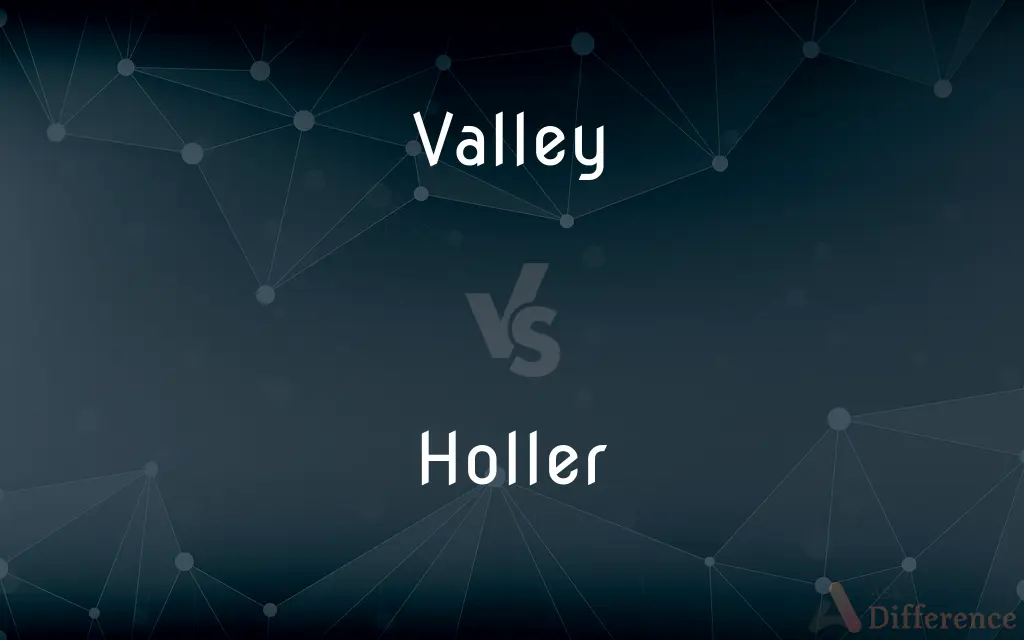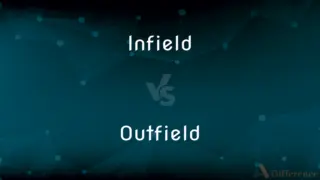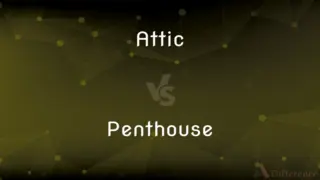Valley vs. Holler — What's the Difference?
By Maham Liaqat & Urooj Arif — Updated on March 22, 2024
A valley is a low area between hills or mountains, often with a river running through it, while a holler is a small valley or hollow, typically more secluded and found in rural areas.

Difference Between Valley and Holler
Table of Contents
ADVERTISEMENT
Key Differences
Valleys are extensive geographical features that can be found in many parts of the world, characterized by their low land between mountains or hills, which may or may not contain rivers. These areas are significant for their role in hydrology, agriculture, and human settlement due to the fertile land and water availability. On the other hand, a holler, a term more commonly used in the Appalachian region of the United States, refers to a small valley or hollow. It is often more secluded, can be heavily wooded, and is typically associated with small rural communities or isolated homes, where the term itself conveys a sense of remoteness and community identity.
While valleys can be vast, stretching for hundreds of miles and visible on maps as major geographic features, hollers are usually not identified on maps. They are smaller, more intimate landforms that might only be known locally. Valleys are often significant for their ecological diversity, supporting a wide range of flora and fauna due to the varying microclimates and the presence of water. Hollers, while also rich in biodiversity, tend to be more isolated, which can lead to a unique ecosystem but on a much smaller scale.
Valleys have been crucial in human history for agriculture, as the flat land and access to water make them ideal for farming. Large civilizations have historically flourished in valley regions, like the Indus Valley. Hollers, in contrast, have not typically been centers of agriculture on a large scale due to their smaller size and more rugged terrain, but they may have small, family-owned farms or gardens.
In terms of habitation, valleys have often been the sites for the development of large cities and towns due to the ease of access, fertile land, and trade routes. Hollers, with their secluded nature, are more likely to host small, close-knit communities or solitary homes. These differences reflect on the social and economic dynamics of the regions, with valleys being hubs of cultural and economic activities, whereas hollers may represent a simpler, more rural way of life.
Valleys are formed through processes such as erosion by rivers or glaciers, and tectonic activity, showcasing a wide variety of shapes and sizes - from river valleys to glacial valleys. Hollers are also the result of erosion but on a much smaller scale, often carved out by small streams or the natural downward flow of water in a more localized setting. This geological difference underscores the vastness of valleys in comparison to the intimate scale of hollers.
ADVERTISEMENT
Comparison Chart
Definition
A low area between hills or mountains, often containing a river.
A small valley or hollow, typically secluded and in rural areas.
Size
Can be vast, extending over hundreds of miles.
Smaller, more intimate, and localized.
Location
Found worldwide, visible on maps.
Common in the Appalachian region, usually not marked on maps.
Ecological Impact
Supports diverse ecosystems and significant for agriculture.
May have unique but smaller scale ecosystems.
Human Settlement
Often sites for cities and large agricultural developments.
Typically host small communities or isolated homes.
Compare with Definitions
Valley
A valley is a broad area of low land between mountains or hills.
The Nile Valley hosts some of the richest agricultural lands in Africa.
Holler
The term "holler" also conveys a sense of remote, rural community.
In the holler, neighbors rely on each other for help and company.
Valley
Valleys often contain rivers that have carved out the valley floor over time.
The Colorado River runs through the Grand Canyon, a steep-sided valley.
Holler
A holler is a small, secluded valley found in rural areas, especially in Appalachia.
We visited a friend’s cabin hidden deep in a holler.
Valley
Valleys can be important for human settlement due to their fertile lands.
The Silicon Valley is known for its tech industry, not agriculture.
Holler
The culture and folklore of holler regions are rich and unique.
Stories and songs from the holler speak of the land’s beauty and hardships.
Valley
Some valleys are formed by tectonic activity, creating rift valleys.
The Great Rift Valley in Africa was formed by the divergence of tectonic plates.
Holler
Hollers are often characterized by their wooded areas and steep slopes.
The dense forests of the holler were ablaze with fall colors.
Valley
Glacial valleys, or U-shaped valleys, are carved by the movement of glaciers.
Yosemite Valley was shaped by glacial action during the last Ice Age.
Holler
Hollers may have streams or brooks, contributing to their secluded charm.
A clear stream winds through the holler, teeming with life.
Valley
A valley is an elongated low area often running between hills or mountains, which will typically contain a river or stream running from one end to the other. Most valleys are formed by erosion of the land surface by rivers or streams over a very long period of time.
Holler
Give a loud shout or cry
He hollers when he wants feeding
‘I can't get down,’ she hollered
Valley
A low area of land between hills or mountains, typically with a river or stream flowing through it
The valley floor
The Thames Valley
Holler
A loud cry or shout
The audience responded with whoops and hollers
Valley
An internal angle formed by the intersecting planes of a roof, or by the slope of a roof and a wall.
Holler
To yell or shout.
Valley
An elongated lowland between ranges of mountains, hills, or other uplands, often having a river or stream running along the bottom.
Holler
(Informal) To complain.
Valley
An extensive area of land drained or irrigated by a river system.
Holler
To shout out (words or phrases).
Valley
A depression or hollow resembling or suggesting a valley, as the point at which the two slopes of a roof meet.
Holler
A yell or shout; a call.
Valley
An elongated depression cast between hills or mountains, often garnished with a river flowing through it.
Holler
(Informal) A complaint or gripe.
Valley
An area which drains itself into a river.
Holler
Variant of hollow.
Valley
Any structure resembling one, e.g. the interior angle formed by the intersection of two sloping roof planes.
Holler
A yell, shout.
I heard a holler from over the fence.
Valley
To form the shape of a valley.
Holler
Any communication to get somebody's attention.
If you need anything, just give me a holler.
Valley
The place of meeting of two slopes of a roof, which have their plates running in different directions, and form on the plan a reëntrant angle.
Holler
(music) A field holler.
Valley
A long depression in the surface of the land that usually contains a river
Holler
Alternative form of hollow.
Holler
(intransitive) To yell or shout.
You can holler at your computer as much as you want, but it won't help anything.
Holler
(transitive) To call out one or more words
Holler
To complain, gripe
Holler
Alternative form of hollow.
The holler tree
Holler
A very loud utterance (like the sound of an animal);
His bellow filled the hallway
Holler
A small valley between mountains;
He built himself a cabin in a hollow high up in the Appalachians
Holler
Shout out;
He hollered out to surrender our weapons
Holler
Utter a sudden loud cry;
She cried with pain when the doctor inserted the needle
I yelled to her from the window but she couldn't hear me
Holler
Complain;
What was he hollering about?
Common Curiosities
What is a holler?
A holler refers to a small, secluded valley or hollow, typically in rural areas of the Appalachian region.
What is a valley?
A valley is a low area between hills or mountains, often containing a river or stream.
Do all valleys have rivers?
Many do, but not all. Some valleys, especially those formed by glacial activity, might not have rivers.
Is the term "holler" used officially in geography?
"Holler" is more of a colloquial term, especially in the Appalachian dialect, and not widely used in formal geographic terminology.
How does the ecology of a holler compare to a valley?
Both can support rich biodiversity, but valleys, due to their size, can support larger and more diverse ecosystems.
Can hollers be found outside the Appalachian region?
While the term "holler" is specific to the Appalachians, similar landforms exist elsewhere but are known by different names.
Are valleys always larger than hollers?
Typically, yes. Valleys can extend for miles and are broader, while hollers are smaller and more secluded.
How are valleys formed?
Valleys are formed through erosion by rivers, glacial movement, and tectonic activities.
Why are valleys important for agriculture?
The flat lands and availability of water make valleys ideal for farming and settlement.
Are hollers only found in wooded areas?
While many are wooded, the defining feature of a holler is its secluded, valley-like nature, not necessarily the presence of woods.
What geological processes form hollers?
Erosion from water flow and the natural downward movement of soil and rock form hollers.
How does the climate in valleys compare to hollers?
Both can have unique microclimates, but valleys, due to their size, might have a wider range of climatic conditions.
What types of communities live in hollers?
Small, often close-knit rural communities or isolated homes are common in hollers.
Share Your Discovery

Previous Comparison
Infield vs. Outfield
Next Comparison
Attic vs. PenthouseAuthor Spotlight
Written by
Maham LiaqatCo-written by
Urooj ArifUrooj is a skilled content writer at Ask Difference, known for her exceptional ability to simplify complex topics into engaging and informative content. With a passion for research and a flair for clear, concise writing, she consistently delivers articles that resonate with our diverse audience.














































